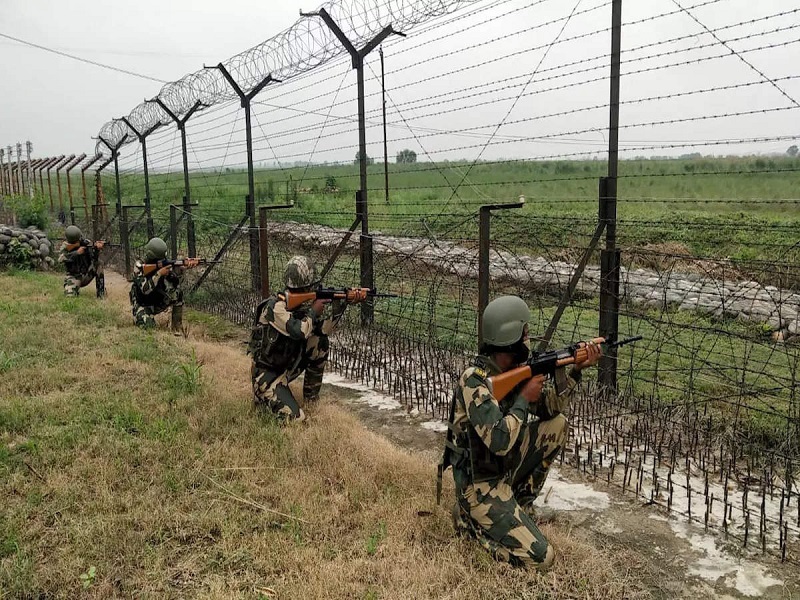
New Delhi: Border Security Force locations along the Line of Control (LoC) will be getting a steel makeover as the paramilitary force embarks on a major project to fortify defences and enhance living facilities for troops along this sensitive high-altitude frontier with Pakistan.
These deployments are called forward defence locations (FDLs), and the border force guards, either jointly with the Army or independently, over 430 kilometres of the total 772-km-long LoC that falls in Jammu and Kashmir.
The FDLs are located in extreme forward snow-bound or dense jungle areas of the LoC and are part of India’s anti-infiltration grid to thwart militant activities being conducted from across this un-demarcated frontier.
Behind the FDLs on the Indian side are multiple rings of the Army’s counter-infiltration deployments.
Troops at these icy locations, having altitudes in the range of 8,000-16,000 feet, at present live in CGI (corrugated galvanised iron) sheet-made hutments along with their rations and weapons, exposing them to the vagaries of sub-zero temperatures.
Official sources in the security establishment told PTI that the BSF will convert about 115 of its FDLs to large steel (alloy of iron and carbon) compartments with an overall layout of around Rs 35 crore.
The decision was taken after BSF Director General (DG) Pankaj Kumar Singh recently visited the FDLs in Kashmir and reviewed their operational preparedness.
The BSF head interacted with his troops and later directed officials of the Kashmir frontier to prepare an action plan for converting those FDLs to steel so that work can be initiated quickly.
The DG, they said, later also met senior officials of the Ministry of New and Renewable Energy in Delhi to get solar power projects sanctioned for these FDLs which have been approved in-principle.
All activities at these locations, including cooking and daily ablutions by BSF troops, are carried out using power sourced from kerosene and diesel, they said.
“The new steel dwelling units will be procured after a tender process. Steel has been thought as the replacement to the present infrastructure as it has better strength and fracture resistance in sub-zero temperatures.
“A bathroom, toilet, kitchen and living unit will be prepared from steel and installed at about 115 FDLs each,” a senior officer said.
He said more locations would be covered after the first phase is implemented successfully.
Another officer said while the Union Home Ministry has approved the decision, the solar power panels that will be installed by the New and Renewable Energy Ministry will help reduce carbon footprint and pollution in these ecologically fragile high-altitude regions.
Moreover, an officer deployed in the Kashmir anti-infiltration grid said BSF troops will get better facilities than what they have at present.
“No doubt it is very hard to survive and protect the borders in these FDL areas as weather is a strong enemy and there is no absolute solution that can ease all the troubles,” they said.
“We are trying to provide our men in uniform what is best available for them in these extreme hard area deployments,” the officer said.
As FDLs cannot have permanent dwelling infrastructure, temporary structures are created to deploy troops, lay ambushes and mount weapons in these areas.
A number of BSF FDLs are named in the memory of troops who were killed in action in this area, while some are identified with the names of Hollywood actresses.
Apart from the LoC, the BSF is entrusted to guard about 2,289 kilometres of the India-Pakistan International Border that runs from Jammu to Punjab, Rajasthan and up to Gujarat on the country’s western flank.
Follow this link to join our WhatsApp group: Join Now
Be Part of Quality Journalism |
Quality journalism takes a lot of time, money and hard work to produce and despite all the hardships we still do it. Our reporters and editors are working overtime in Kashmir and beyond to cover what you care about, break big stories, and expose injustices that can change lives. Today more people are reading Kashmir Observer than ever, but only a handful are paying while advertising revenues are falling fast. |
| ACT NOW |
| MONTHLY | Rs 100 | |
| YEARLY | Rs 1000 | |
| LIFETIME | Rs 10000 | |













